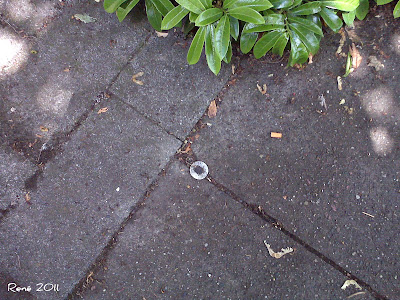Brake time and out the front entrance to Eastlake Ave. What a gorgeous summer morning and a short walk is just what I need. A couple doors down from the office my eye catches this survey tag in the sidewalk. I'm sure I've seen it before, but today it grabs my attention and sparks a line of inquiry about surveying, especially its history.
Over the 4th of July weekend with our “independence” on my mind I'm thinking about George Washington. He was a surveyor. Of course I couldn’t just stop here... Who else? It's interesting that so many of our great leaders were about land and real estate.
George Washington was just 17 years old when he was appointed to Surveyor General for the State of Virginia in 1749 and Thomas Jefferson would later hold that same position. In 1833 Abraham Lincoln ran a general store just outside of Springfield Illinois where he was also the Postmaster and a Deputy County Surveyor.
King County survey from 2004 showing the location of a center line monument.
For me it gets really interesting (being a native of the Pacific Northwest) when the “Corps of Discovery” leave Wood River, Illinois on May 14, 1804. Meriwether Lewis, personal secretary to President Thomas Jefferson, and William Clark, a surveyor, mapmaker, and explorer, head west. Lewis & Clark did an amazing job of mapping their route all the way to the Pacific Ocean where near the mouth of the Columbia River they built Fort Clatsop and wintered from December 1805 to March 1806.
One of their challenges was accurate timepieces which made it difficult to measure Longitude. Despite their crude tools compared to our modern standards (no digital satelite photos or high res Google Earth or Bing images) they created very precise estimates of distance traveled everyday and used Latitude to create surprisingly accurate maps. Yet they were actually about a ½ degree further north than what they reported.

Surveyor on Broadway Ave E on Capitol Hill.
There wasn't much settlement before the 1840’s in the Oregon Territory (now Washington, Oregon, Idaho, and parts of Montana and Wyoming). Mostly fur trappers and traders from the Hudson Bay Company and missionaries started showing up around 1830. The Lewis & Clark expedition was scientific, but Jefferson also had his mind on finding an efficient route to the Pacifc Ocean in hopes of creating commerce which would surely bring settlers.
The early routes of the fur traders (1811 - 1840) were unpassable by wagon but they would later become the Oregon Trail. The first wagon train left Independence, Missouri in 1836 and made it to Fort Hall, Idaho. In 1843 the trail was extended to The Dalles, Oregon, and 3 years later wagon trains were making it around Mt Hood to the Willamette Valley.
More from the 2004 survey denoting locations of rebar with survey caps.
An ambitious surveyor from Maine, Samuel Thurston, came over the Oregon Trail in 1847 and settled in Hillsboro, Oregon where he practiced law. Thurston later became a congressman and authored the Donation Land Claim Act of 1850. The DLC was one of the most important congressional acts in our history to open up settlement in the Pacific Northwest.
Thurston was only 35 when he died at sea of Panama fever on his return from congress in 1851. Thurston County, Washington was created in 1852 and named in his honor.

Another survey tag I discovered in a parking lot in Tacoma.
Last but not least in my little inquiry today is Isaac Stevens, a West Point graduate. Stevens was a surveyor, explorer, and a military hero. He lead an Army survey crew in 1853 to map a transcontinental railroad route to the west coast. He surveyed a northern route from St. Paul, Minnesota to Fort Vancouver on the Columbia River then up to Puget Sound. Soon after he arrived he became the first Govenor of the newly formed Washington Territory and settled in Olympia, Washington. Our Stevens County was named after him.
Later when the Civil War broke out in 1861 and the Union Army was defeated at the First Battle of Bull Run Stevens was commissioned once again to the Army as Colonel of the 79th New York Volunteers. Several promotions later Brigadier General Stevens is in Virginia at the Second Battle of Bull Run.
In Chantilly, like right out of a movie, his troops are hard hit and in bad shape. He picks up his old regimental colors and with flag and staff in hand rallies his troops and led the charge into battle. Stevens took a bullet in the temple that day and died instantly on September 1, 1862.
We owe a lot to so many. It was all about the land.
Originally posted on Activerain.com, July 8, 2011



No comments:
Post a Comment